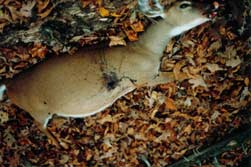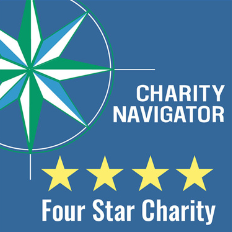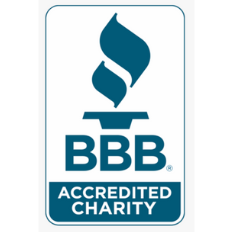Hunting

The Effect on Animals
Sport hunting and the noise, fear, and predation associated with it causes great stress to all animals. It hampers their ability to find and store enough food to sustain them through the winter. Moreover, hunting has profound effects on animals such as wolves who have tight-knit family units and mate for life. Finally, many farm and companion animals are wounded and killed by hunters, especially intoxicated ones.
Some wildlife agencies set hunting seasons on animals during the time that they give birth to and nurse their offspring. As a result, mothers are often killed while searching for food for their young. The defenseless children then die of starvation or are killed by predators.
Types of Weapons Used by Hunters
- Rifles
- Shotguns
- Handguns
- Muzzleloaders
- Bows and arrows
For every animal a hunter kills and recovers, he wounds at least two others who die slowly and painfully from blood loss, infection, or starvation.
Ethics
Hunting is an inherently unfair “sport.” While the hunter has a powerful weapon at his disposal, the animal is unarmed and helpless. Moreover, the vast majority of hunters kill not for food but as recreation. Most target species, squirrels and raccoons, for instance, provide little sustenance. Additionally, when the costs of acquiring license fees, equipment, transportation and the like are considered, hunting expenses generally outweigh the money that it might save.
Trophy hunters sometimes engage in baiting, during which they dump piles of rotten food on public lands. They then shoot hungry deer or bears that come to feed on it. Trophy hunters also practice hounding: they put radio-collars on their dogs, who chase animals up trees. The hunters then follow the radio signal and shoot the trapped animal off of the tree branch. Others use global positioning satellite systems.
Bow hunting cripples approximately 50% of struck animals. They then bleed to death or die from infection or disease. During contest kills, contestants compete to see who can kill the most animals while onlookers cheer; prairie dogs and pigeons are among the most popular targets of such hunts.
Canned Hunts: "No Kill, No Pay"
The wealthy pay to kill exotic and native animals at fenced in hunting facilities. Animals used in canned hunts are either purchased from animal dealers, bred in captivity, or are former zoo and circus animals. Because baby animals are more popular, zoos often sell adults to canned hunt facilities or dealers who will later sell the animals to such facilities. The animals are often so tame and accustomed to humans that they do not run when approached by hunters. These captive animals are then shot or struck by hunters who typically wound the animals many times in the body so as not to spoil the “trophy” head of their kill. As a result, the animals die slow, painful deaths.
Types of Animals Commonly Killed in Canned Hunts
- Lion
- Boar
- Buffalo
- Ram
- Antelope
- Elk
- Rhinoceros
Non-Native Species
Hunters sometimes shoot species such as ring-necked peasants who are raised in pens and socialized by humans. Just before hunting season, these species are released into the wild. Those that are not killed by hunters will die of starvation and exposure, as they are unable to survive in a nonnative environment.
"What is it but deliberate massacre when tens of thousands of tame, hand reared creatures are every year literally driven into the jaws of death and mown down in a peculiarly brutal manner? A perfect roar of guns fills the air; louder tap and yell the beaters, while above the din can be heard the heart-rending cries of wounded hares and rabbits, some of which can be seen dragging themselves away, with legs broken, or turning round and round in their agony before they die! And the pheasants! They are on every side, some rising, some dropping; some lying dead, but the great majority fluttering on the ground wounded; some with both wings broken and a leg; others merely winged, running to hide; others mortally wounded, gasping out their last breath amidst the hellish uproar which surrounds them. And this is called “sport!” —Florence Dixie
The Effect on Animal Populations
Contrary to their claims, hunters do not kill animals that would otherwise starve to death. Instead, they hunt either at random or by focusing on killing those animals with the biggest antlers, i.e. those that would make the best “trophies.” In doing so, they kill the strongest members of the population, thereby interfering with natural selection and weakening the population as a whole.
Hunters manipulate animals’ habitat by burning and bulldozing forests to increase the d supply for target species, at the expense of non-target species. Hunting programs also cause wildlife overpopulation by maintaining “buck only” hunts, which result in a disproportionate number of does, and also by annihilating predators to increase the number of prey. Lastly, hunters move some animals such as raccoons and antelopes to other states to increase the amount of “game” in the latter, therein disturbing the ecosystems of both states.
Endangered Species
1973’s Endangered Species Act was created largely as a result of the animal extinction caused by hunting. Hunters continue to kill endangered animals or those on the brink of endangerment, sometimes because they are unable to properly identify exactly which species of animal they are killing. This inability is most serious before sunrise when the hunting day begins.
Some of the Species Eliminated by Hunters
- Great auk
- Passenger pigeon
- Heath hen
Wildlife Agencies
While wildlife agencies theoretically exist to benefit all citizens, they have become decidedly pro-hunter. Because most of their revenue is generated from the sale of hunting licenses, their goal is to protect sport hunting, not wildlife. Although less than 7% of Americans hunt, hunting is permitted on 60% of wildlife refuges and in many state parks and forests. Thousands of hikers, campers, and other people are injured by hunters each year.
Youth Recruitment Hunts
Most states actively recruit children into hunting, often on National Wildlife Refuges. Many set no minimum limits on the age of child participants. Some states, North Carolina for instance, allow hunting education to be presented during public school class time. Such presentations sometimes include bringing firearms into schools and teaching children how to use them. Many of the children involved in recent school shootings were raised in hunting households. Some committed their crimes with hunting weapons, demonstrating the connection between violence against animals and violence against humans.
Hunting sends the message that it is acceptable and even fun to kill and maim other living things. Killing non-human animals desensitizes children to the suffering of other creatures. It teaches them that they have the right to exercise their power over others violently simply because they are bigger, stronger, or well-armed.
You Can Help:
- Protest organized hunts.
- Contact the U.S. Fish and Wildlife Service and explain that you do not want to see government funds spent on youth recruitment hunting programs.
- Ask your elected officials to enact and enforce wildlife protection laws. For their contact information, visit www.vote-smart.org.
- Post “No Hunting” signs on your land and spread deer repellent near hunting areas.
- Do not contribute to “conservation” groups that support hunting, such as the National Wildlife Federation, The Sierra Club, the Wilderness Society, the World Wildlife Fund, and the National Audubon Society.
- Contact your state wildlife agency, attend meetings, and voice your opinions about the importance of protecting animals.
- Report poachers in national parks to the National Parks and Conservation Association at (800) 448-NPCA.
- Educate others about the cruelty involved in hunting.











